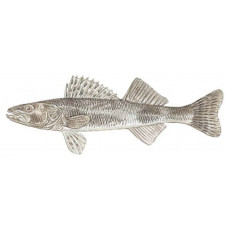Latin name
Stizostedion canadense
Other names
Sand pickerel, sand pike, blue pickerel, pike, gray pike, blue pike, river pike, pike-perch, spotfin pike, jack, jack fish, jack salmon; French: doré noir.
Identification
The body of the sauger is slender and almost cylindrical, and the head is long and conical. The back and flanks are dull brown or olive gray with yellow patches fading to white on the belly. There are three or four dark saddle patches on the back and flanks. It is easily distinguished from the smooth-cheeked walleye by the presence of coarse scales on the cheeks and two or three rows of distinct black spots on the dorsal fin band, the absence of a large spot on the anterior dorsal fin, and the absence of a white tip on the tail. The eyes are large and bright and the teeth are large and sharp.
Distribution
This species has a general distribution in mid-central North America from Quebec to Tennessee and Arkansas and northwest through Montana to about central Alberta. Between Alberta and Quebec, it occurs in southern Saskatchewan, Manitoba, and Ontario, and across the Great Lakes to James Bay. It does not occur east of the Appalachians and well south of Tennessee, except in a few rivers where it has been introduced, mostly from the Carolinas through the lower coastal states to southern Texas in the lower Gulf of Mexico.
Habitat
It prefers large, muddy, shallow lakes and large, muddy, slow-flowing rivers. It is more tolerant of murky water and faster currents than walleye and prefers water temperatures between 62° and 72°F. It is often found in tailwaters below dams and along rocky bluffs. Stopping and feeding areas are often breakwaters near turbulent water. Gravel bars and points are notable staging areas in lakes.
Size
Sauger are usually caught in sizes from 10 to 16 inches and weighing up to 11⁄2 pounds. Specimens larger than 22 inches and 5 pounds are rare. The maximum size is about 9 pounds, and the world all-tackle record is 8 pounds, 12 ounces, caught in North Dakota in 1971. Life expectancy is 10 to 12 years.
Life history and Behavior
Males mature at 2 years of age, females at 3 or 4 years of age. They spawn when water temperatures reach 41° to 46°F. Adults enter backwaters or tributaries or congregate in tailwaters and seek out gravel or rocky substrate on which to lay eggs. In large river systems, upstream spawning runs may extend 100 to 200 miles, although they are quite small from reservoirs to tributaries. In reservoirs where they occur with walleye, they usually spawn immediately after the walleye. Sauger can naturally interbreed with walleye, producing a fish called saugeye. However, the sauger grows more slowly than the walleye and is primarily a stream fish that lives near the bottom on a variety of bottom types. Like the walleye, the sauger is a schooling fish.
Food and feeding habits
The Sauger feeds on small fish such as shad, sunfish, and minnows, as well as crustaceans, leeches, and insects. Feeding takes place mainly on rocky and gravelly bottoms or along sparse grassy sandy bottoms.
Reproduction
No information
| Classification | |
| Phylum | Chordata |
| Class | Actinopterygii |
| Squad | Perciformes |
| Family | Percidae |
| Genus | Sander |
| Species | S. canadensis |
| Features | |
| Conservation status | Least Concern |
| Habitat | Pelagic |
| Life span, years | 12 |
| Maximum body weight, kg | 0.4 |
| Maximum length, cm | No information |
| Sailing speed, m/s | No information |
| Threat to people | Edible |
| Way of eating | Predator |
Sauger
Tags: Sauger

